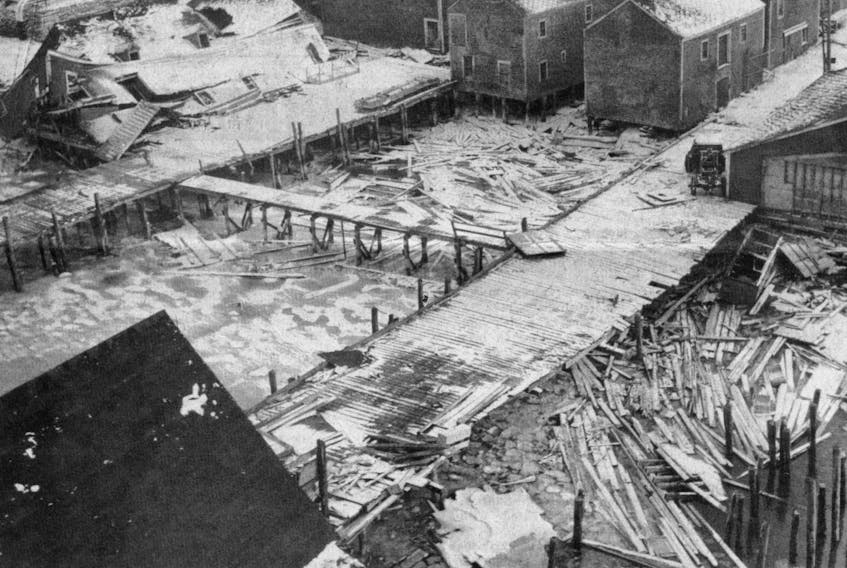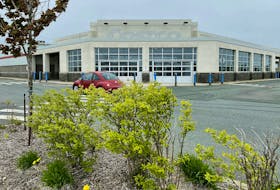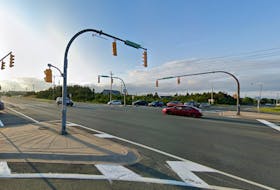YARMOUTH, N.S. — It’s nearly impossible for any Feb. 2 – Groundhog Day – to roll around in southwestern Nova Scotia without people thinking back to the Groundhog Day storm of 1976.
On a day when the weather forecast was for warm temperatures and 30 mph winds, the region got walloped by strong winds, storm surges and power outages that went on for days. Sustained wind speeds of 135 mph (200 kilometres per hour) were clocked over Grand Manan and they topped 100 mph (160 kilometre per hour) in Yarmouth.
The storm devastated fishing communities where boats were tossed around and wharves were destroyed by the wind and the storm surge.
Power outages were extensive and lengthy. School were closed and children spent days at home. Due to the power outages, businesses were closed too.
There was destruction everywhere.

Revisiting the storm
We’ve revisited the Ground Hog Day storm of ’76 many times over the decades. Here’s a throwback to photos and some past coverage from anniversaries of the storm.
Some of the voices in these stories have since passed on, but their memories live on through their experiences as well.

From FEBRUARY 2016:
Forecasting has come a long way since 1976 Groundhog Day storm
Like the uninvited visitor from hell, the Groundhog Day storm blew into the region unexpectedly and took people by surprise. Times have changed said a meteorologist with Environment Canada during a 2016 interview.
From FEBRUARY 2011:
Remembering the Groundhog Day storm
The Groundhog Day storm blew through the Bay of Fundy 35 years ago this week and into the history books. It was the storm of the century. Before the storm blew itself out, it had redrawn the coastal map, brought devastation to fishing communities from Baccaro to Westport, reduced fishermen’s wharfs and farmers’ barns to sticks and forced everyone to confront the realities of a world without electricity.
The damage sustained by the storm’s relentless assault has etched itself into our collective memory.

From February 2016:
Shelburne County during the Groundhog Day storm: 'It was wild'
“It was a warm day,” recalled Leigh Stoddart of Clark’s Harbour, during a 2016 interview while he was still the mayor of this small town. “I was working and the wind it kept picking up, and picking up and picking up.”
Fishermen went running to get their boats secure as the waves picked up to 20 feet and the wind blew to 90 knots and more. “It was wild,” he said. “Anything not secured down was flying everywhere.”
From February 2016:
Great big sea: Westport store keeper escapes through water to his waist
Raymond Robicheau had just finished saying he’d seen rough weather before, when a great big sea demolished the building he was in.
“Within a half hour my whole store was gone, everything washed away,” he remembered, clear as a bell, 40 years later, during a 2016 interview.
From February 2016:
Groundhog Day storm of 1976: 'It was devastating'
When the Yarmouth Vanguard newspaper came out a few days after the storm in ‘76, the words at the top of the front page summed it up: “Vicious storm cripples region.”
The unexpected storm destroyed wharves, mobile homes and more. It took its toll on vessels, washed out roads, uprooted trees and left many people without power for days. Commercial and industrial enterprises suffered losses too.
“It was devastating,” recalled Alain Meuse in a 2016 interview, who was editing the newspaper at time. “The next day, my God. (There were) boats in the trees … It was really something.”


5 things to know about the Groundhog Day storm
- It struck on Feb. 2, 1976. The storm packed winds of 160 km/h in southwestern N.S.
- The fishing industry in southwestern Nova Scotia was heavily impacted, Boats were damaged or sunk. Wharfs were broken apart. And thousands of lobster traps went missing.
- Although the Yarmouth hospital was equipped with an emergency generator, during the power outage unnecessary lights were kept off, an x-ray machine was shut down and laundry operations were restricted.
- Many roofs on buildings were damaged.
- Mobile home parks in southwestern N.S. saw severe damage. One woman and a child in Yarmouth were treated for cuts and bruises after the mobile home they were in rolled several times.



Also from 1976...
As we revisit the storm, here's a look back at some of the other things that were happening in the world in 1976, from politics to popular culture.
- Pierre Trudeau was Canada’s prime minister. His oldest son, Justin, was four years old.
- Gerald Regan was premier of Nova Scotia.
- Gerald Ford was president of the United States.
- The number-one single on the Billboard pop chart was Love Roller Coaster by the Ohio Players. (Barry Manilow was next with I Write the Songs.)
- Had you been watching TV the night before the storm – that is, Sunday night, Feb. 1, 1976 – you might have seen The Waltons or the Sonny and Cher Show or maybe Kojak.



Student recollections from 1976
Following the Groundhog Day storm of 1976, a book called Tidal Wave was compiled by retired Ruth Specht of Barton, in which students from around the Tri-County area shared their storm experiences. Here is some description of experiences from that book.

Cape Sable Island School
On Feb. 2, 1976, we had the worst storm I ever experienced. The highest winds were 117 miles an hour. Boats broke away from the wharf at Clark’s Harbour. Down the inlet at Southside, a transformer caught fire and a boat sank. The power lines blew down and we were without power for three days. We had little heat and light.
Trevor Nickerson
West Pubnico School
After school, I went over to my friend’s house. We had to walk there in that fierce wind. With no power, we had no TV, stereo nor tape. I stayed all night. We slept in sweatsuits with seven blankets, yet we were cold… our noses, hands, feet, faces… At home, another family had come. There the fireplace was crackling. My father and mother stayed up all night putting the wood on. The worst of the storm was the sea, the cold and the wind!
Angele Saulnier

Weymouth Consolidated School
At noon hour some people came up from town and said Weymouth was flooded. The wind was blowing quite hard but we went downtown just the same. As we ran down the wind was in our faces. We could taste the salt on our hands…We saw people wading up to their waists trying to reach their cars.
Denise Jarvis
Yarmouth Central School
When that terrible storm came, a lot of things got wrecked and flooded. On Water Street, where the cotton mill is, the street was flooded. Cotton from the mill was across the harbour on the bank.
Lisa Nickerson
Cape Sable Island School
The outrageous storm swept over the Atlantic like a bird on wings. It took everything in its path. The power was off all over Cape Sable Island. People were driven into other homes. I was at a home where there were 19.
Brenda Atwood


Barrington High School
Groundhog Day started as any other day. There was a brisk southwest wind, the sky was overcast. By 12 o’clock the tide was full and so was the wind. Before noon the power was cut off from falling trees and also from salinity in the air crystallizing on the wires.
Some of the worst damage was a couple of boats broke loose and went ashore on the rocks. The fishermen’s private wharves were washed away, along with what was on them. One lobster dealer lost 3,500 lbs. of lobsters when his lobster cars broke loose and went ashore.
Two fishing boats were out from Clark’s Harbour but they managed to reach the port of Shelburne safely.
Grant Smith, Clark’s Harbour
Barrington Municipal High School
We had to cross the causeway. It was being washed out. On it were rocks and seaweed and large holes. The light poles were bending. Then came a gust of wind. Our bus went to the other side… almost off into the water. We screamed. I’ll never forget that day.”
Beatrice Brannen
West Pubnico School
The night was cold. Candles were burning. A propane stove provided heat for supper. At the Sealife Plant four Pubnico boats were battling fiercely but no one could do anything. We watched the boats float down the harbour to their destruction.
Georges P. d’Entremont
Arcadia Consolidated School
I don’t know how the Groundhog Day storm affected you, but here’s how it affected me. We had a hedge… it went like a feather. One of our barn doors came tumbling down. The shingles came off our barn like big flocks of black birds. That night the power lines were crackling.
Jerry Hayes, Brooklyn

Cape Sable Island School
We were almost to the causeway when we saw a car coming across. A big wave came and went right over the top of the car. When I got home I almost blew into the woods
Yvonne Brannen
Digby Regional High School:
By afternoon the storm became furious. Damage had begun. School had been dismissed. Some of the students from Digby Neck could not get home for the night due to roads being flooded and washed out. Later the bus trip home was like a tour through a disaster area.
David Switzer
Arcadia Consolidated School
We couldn’t go home (from school), we had to wait for the tide to go down. As we ate our lunch we had to pull out chairs far from the windows that could be shattered from the flying rocks.
Debbie Boudreau
Yarmouth Central School
I had to do my paper route. As I ate breakfast I heard the howling wind. I dreaded having to go out. It was raining. I heard a crash. Our garbage can came rolling down the driveway, all the trash was scattered over the lawn. It was impossible for me to ride my bike. The wind got a hold of my paper bag, took it off like a piece of paper.
I had much trouble getting to the office. There the other boys were waiting for the storm to let up. After a while I left. At the first house I pulled out my paper… a heavy wind took the paper out of my hands and it was gone! My paper route was located down by the IMO fish plant. As I turned the corner the wind came fast and I was thrown to the ground. When I reached Sanborn’s Trucking Lodge I fell, nearly landed in a water puddle. When I got home from the route I went to bed!
Gordon Sisco
Port Maitland Consolidated School
The bus was crowded. The pressure of the wind plugged everyone’s ears. Halfway home two people had to go on the hood of the bus to get the salt off the windshield. The bus driver George was very nervous.
At home, my cousin and I stood on a tree root as it raised and lowered. Our enjoyment turned to horror when Mom and Dad came from the Yarmouth Bar. They told of the destruction of boats. Five boring days followed at home.
Steven Watkins

Hebron Consolidated School
The storm hit Pembroke. We had little damage done but a few things did happen. A couple of windows were broken, animals were jumpy, boats were banging together, but none were seriously damaged.
Bobby Bain had to move from his house, he had no heat. Bobby Cushing and his family huddled in the kitchen near a propane stove. Dawn Bain’s horse was so jumpy, it got out of its stall and went through an unsafe part of the barn floor. Men from the community rushed to get it out. It is ok now and almost ready to ride again.
Shelley Goodwin
Port Maitland Consolidated School
The winds were so strong thousands of lobsters were washed up on the beach where Beaver River and Salmon River meet. We carried up many burlap bags of lobsters. We cooked lobsters while others waited to be cooked. We ate lobster sandwiches every day for a week.
Terry Bullerwell
Digby Regional High School
From the tiny box in the wall a voice told all the students to leave the school to go home. At this point I left the protected environment of the school and went out into the dangerous world. Loose debris was flying through the air; utility poles were down in a number of streets. I saw several men on a roof stopping shingles from flying off. I would have been more concerned about my life.
As I turned into our driveway I heard the fire siren. I looked. I could see sparks from a neighbouring chimney. Things were soon under control. Later I saw a hat fly past the window. I’m sure its owner never saw it again.
Jacqueline Journeay, Digby

Island Consolidated School, Freeport
I started off for school. As I was sitting in my seat working I saw the sawdust coming down by the buckets. It went in my hair and all over my clothes and seat too. The floor was covered. A rock went through a window in the next classroom.
We watched the big waves roll over the bridge. It swiped the rail off. The road around the cove was washed out. It destroyed our fish factory.
Sharon A. Stanton
Weymouth Consolidated High
In Weymouth… one big wave and everything was flooded. In New Edinburgh, waves were splashing over the top of trees 50-75 feet high. It washed out the bridge and a brand new boat broke loose. The boat drifted out to sea, the back end cutting into the waves and going straight out instead of going in toward town with the big waves. It was found four days after, all smashed up.
Many trees were blown over across the pavement, blocking traffic. Power lines were down; roads were washed out. In Weymouth North, boats were carried across the pavement. One went over on Roy Thurber’s lawn. It was his own boat. Mr. Thurber slept in his new boat during the storm. He did not want to lose it as did the man in New Edinburgh.
Robert Wagner
Yarmouth South Centennial School
I think the groundhog was just coming out when the storm struck, then went back to his beautiful dirty bed, after eating a cheeseburger. He probably slept for a number of weeks before he came back out.
Patsy Muise









